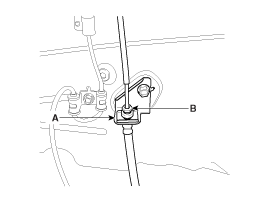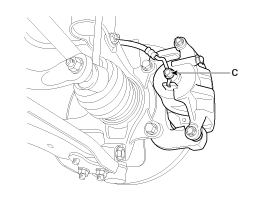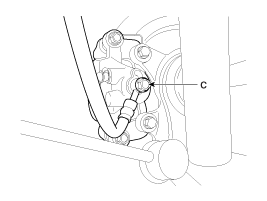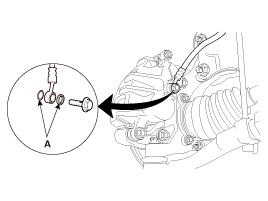 Kia Sportage: Brake Line: Repair procedures
Kia Sportage: Brake Line: Repair procedures
Third generation SL (2010ŌĆō2016) / Kia Sportage SL Service & Repair Manual / Brake System / Brake System / Brake Line: Repair procedures
| Removal |
| 1. |
Disconnect the brake fiuid level switch connector, and remove the reservoir cap. |
| 2. |
Remove the brake fluid from the master cylinder reservoir with a syringe.
|
| 3. |
Remove the wheel & tire. |
| 4. |
Remove the brake hose clip (A).
Front
Rear
|
| 5. |
Disconnect the brake tube by loosening the tube flare nut (B).
|
| 6. |
Disconnect the brake hose from the brake caliper by loosening the bolt (C).
Front
Rear
|
| Inspection |
| 1. |
Check the brake tubes for cracks, crimps and corrosion. |
| 2. |
Check the brake hoses for cracks, damage and fluid leakage. |
| 3. |
Check the brake tube flare nuts for damage and fluid leakage. |
| 4. |
Check brake hose mounting bracket for crack or deformation. |
| Installation |
| 1. |
Installation is the reverse of removal.
|
| 2. |
After installation, bleed the brake system. (Refer to Brake system bleeding) |
| 3. |
Check the spilled brake oil. |
 Brake Line: Components and Components Location
Brake Line: Components and Components Location
Components
...
 Brake Pedal: Components and Components Location
Brake Pedal: Components and Components Location
Components
1. Cowl bracket2. Brake pedal member assembly3. Stop lamp switch4. Return spring5. Brake pedal stopper6. Clevis pin7. Snap pin8. Brake pedal
...
Other Information:
Rain Sensor: Schematic Diagrams
Circuit Diagram
...
Repair procedures
Adjustment
TCM Learning
When shift shock is occurred or parts related with the transaxle are replaced, TCM learning should be performed.
In the following case, TCM learning is required.
...
Categories
- Home
- Kia Sportage QL (2015-2019) Owners Manual
- Kia Sportage QL (2015-2019) Service Manual
- Kia Sportage SL 2010-2016 Owners Manual
- Kia Sportage SL 2010-2016 Service Manual
Copyright ® www.kispmanual.com 2014-2025






